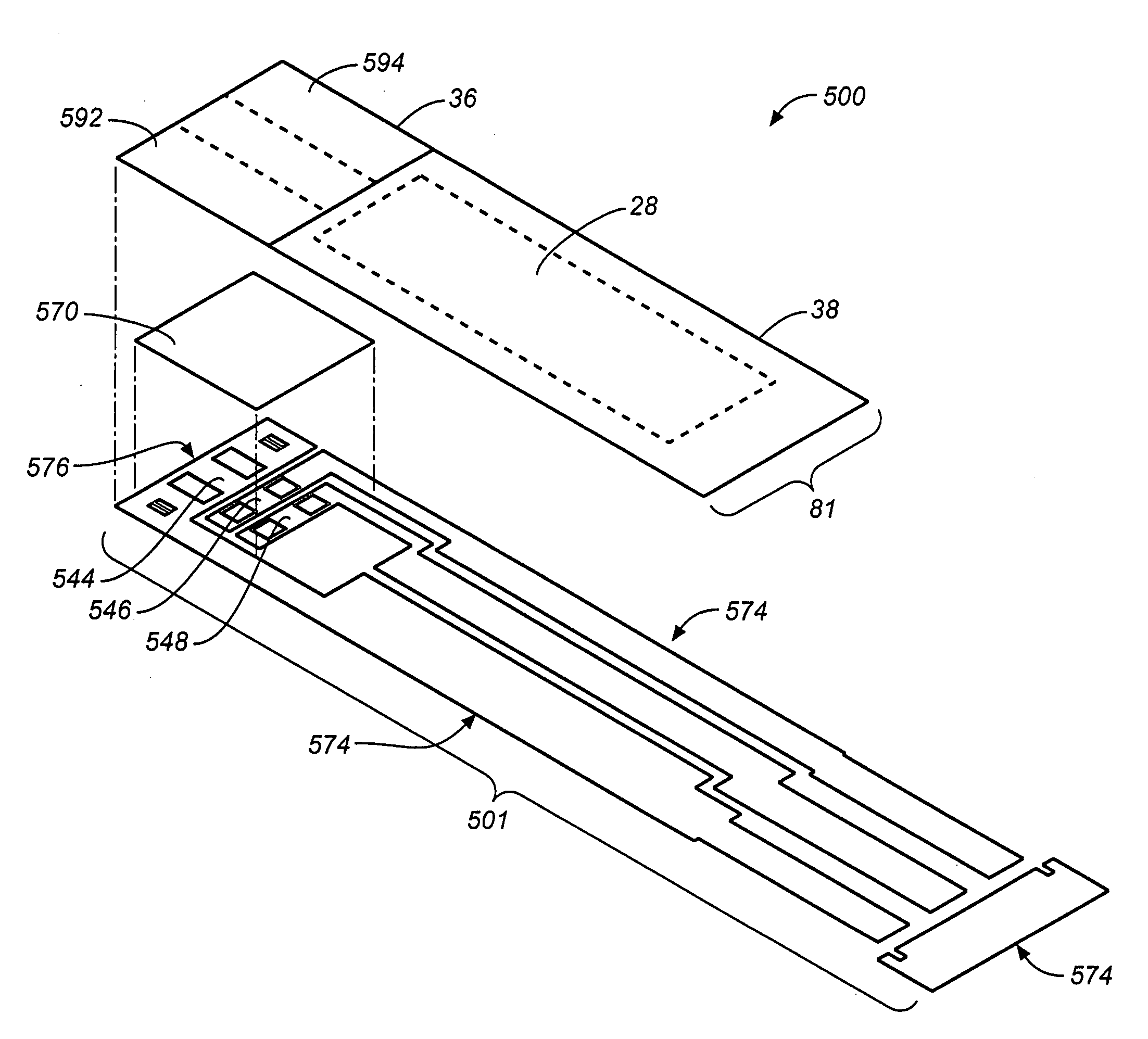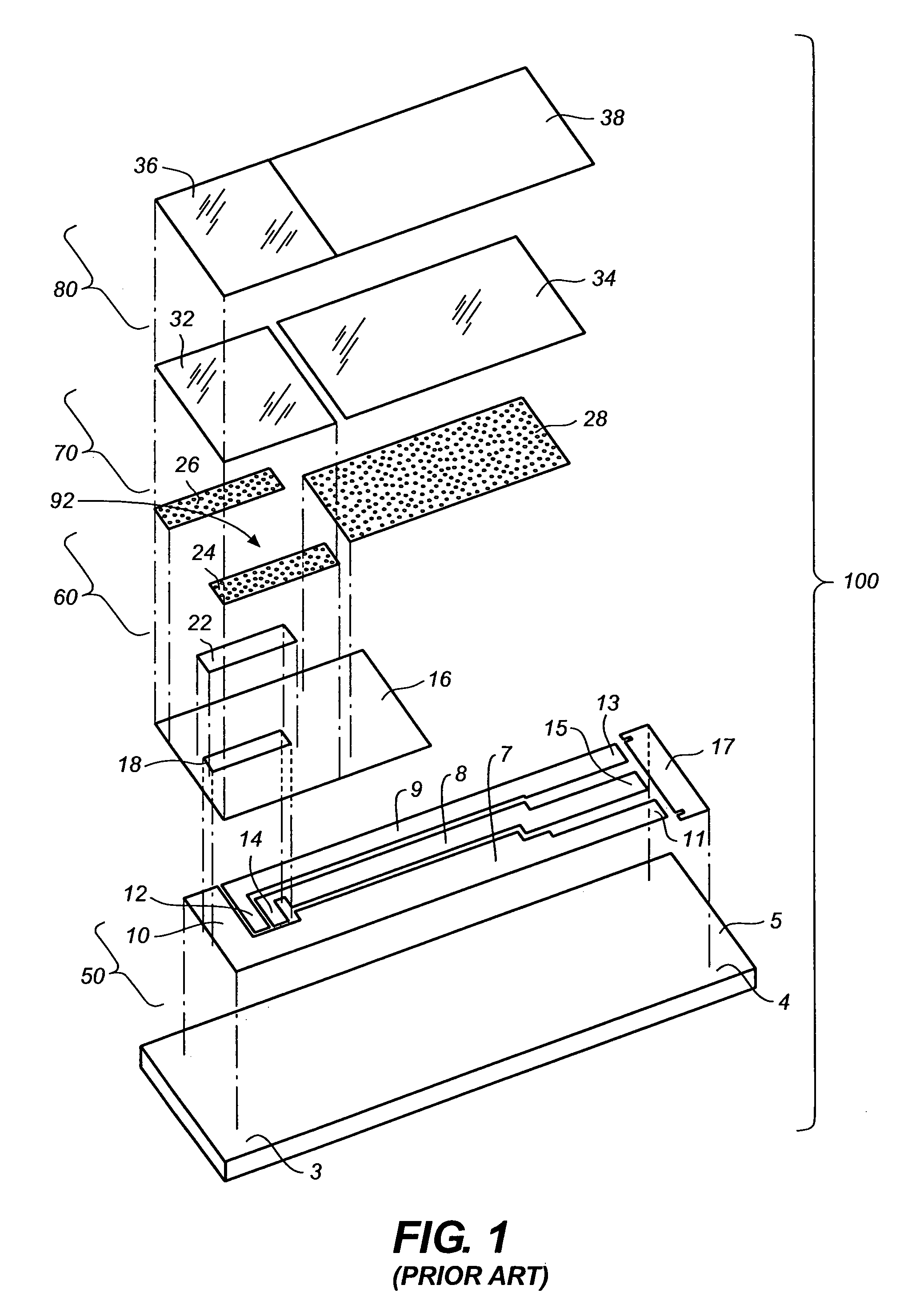A reagent formulation using ruthenium hexamine as a mediator for electrochemical test strips
- Summary
- Abstract
- Description
- Claims
- Application Information
AI Technical Summary
Benefits of technology
Problems solved by technology
Method used
Image
Examples
example 1
[0056]The reagent layer was formulated as an enzyme ink suitable for screen printing as follows. 100 ml of 200 mM aqueous phosphate buffer was adjusted to pH 7. A mixture was formed by adding 5 g of hydroxyethyl cellulose (HEC), 1 g of poly(vinyl pyrrolidone vinyl acetate) (PVP-VA S-630), 0.5 ml of DC 1500 Dow Corning antifoam to 100 mL of phosphate buffer and mixed by homogenization. The mixture was allowed to stand overnight to allow air bubbles to disperse and then used as a stock solution for the formulation of the enzyme ink. Next, 7.5 grams of Cab-o-Sil TS610 was gradually added by hand to the mixture until about ⅘ of the total amount of Cab-o-Sil TS610 had been added. The remainder Cab-o-Sil TS610 was added with mixing by homogenization. The mixture was then rolled for 12 hours. About 18 g of ruthenium hexamine ([RuIII(NH3)6]Cl3) was then added and mixed by homogenization until dissolved. Finally, 2.8 g of glucose oxidase enzyme preparation (250 Units / mg) was added and then t...
example 2
[0057]A first batch of test strips 100 was prepared using a ruthenium based reagent formulation as described in Example 1. A second batch of test strips 100 was prepared with a reagent formulation using a ferricyanide mediator instead of ruthenium hexamine in a manner similar to Example 1. A portion of the first and second batch of test strips 100 were stored at room temperature in a desiccated environment for 7 days. Another portion of the first and second batch of test strips 100 were stored at 40° C. in a 70% relative humidity environment for 7 days.
[0058]The first and second batch of test strips were tested in a test meter using a test voltage at +400 mV. Blood samples were tested which had a glucose concentration ranging from about 70 mg / dL to about 600 mg / dL.
[0059]FIG. 8 is a graph showing that average bias to reference measurement for the second batch of test strips had a positive bias to reference measurement when they were stored for seven days at 40° C. in a 75% relative h...
example 3
[0061]The first and second batch of test strips (as described in Example 2) were tested in a test meter using a test voltage at +400 mV. Blood samples were tested which had a glucose concentration of about 70 mg / dL and a uric acid concentration ranging from about 0 mg / dL to about 20 mg / dL.
[0062]For the second batch of test strips as illustrated by open triangles in FIG. 10, the average bias to reference measurement of the test strip measurements increased with increasing amounts of uric acid in an approximately linear manner. Therefore, test strips using a ferricyanide based reagent layer showed that uric acid, which is an interfering compound, can be oxidized by ferricyanide creating a non-glucose related increase in the test current.
[0063]For the first batch of test strips as illustrated by filled in diamonds in FIG. 10, the average bias to reference measurement of the test strip measurements did not increase with increasing amounts of uric acid. Therefore, test strips using a rut...
PUM
| Property | Measurement | Unit |
|---|---|---|
| Temperature | aaaaa | aaaaa |
| Fraction | aaaaa | aaaaa |
| Fraction | aaaaa | aaaaa |
Abstract
Description
Claims
Application Information
 Login to View More
Login to View More - R&D
- Intellectual Property
- Life Sciences
- Materials
- Tech Scout
- Unparalleled Data Quality
- Higher Quality Content
- 60% Fewer Hallucinations
Browse by: Latest US Patents, China's latest patents, Technical Efficacy Thesaurus, Application Domain, Technology Topic, Popular Technical Reports.
© 2025 PatSnap. All rights reserved.Legal|Privacy policy|Modern Slavery Act Transparency Statement|Sitemap|About US| Contact US: help@patsnap.com



